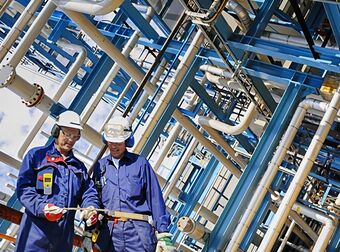 Since 2001, Technology Learning Center as established itself one of the leading trade schools for aspiring pipefitting professionals. With pipefitting careers in high demand, you may be interested in the profession, but not be fully aware what exactly what a professional pipefitter does on a day-to-day basis. With that in mind, here is an overview of this profession that, according to the US department of Labor, is expected to grow in demand at the rate of 14% annually through the year 2025. In short, pipefitters start with a blueprint and make it a reality. These craftsmen are responsible for every aspect of the installation and maintenance of piping systems. Pipefitters fitters work with metals such as carbon and stainless steel, as well as other alloy metals. These metals are shaped through welding and bending to fit specifications for industrial use. Fitters are involved in the process from planning to installation, and will work with tools such as levels, grinders, dies, and welding torches. A steamfitter will typically create a sketch or a blueprint of a pipe installation, or be called upon to interpret existing blueprints. During this process, the fitter is also responsible for selecting the type and size of the pipe, as well as determining other related materials and equipment that are required for the project. From there, the fitter will manipulate metal to form the pipes according to specifications. Types of manipulation that a pipefitter will perform on pipes and metal include but are not limited to:
When the pipes are ready, the fitter will transport them on location and install them. The installation is very important and workers must take care to avoid obstructions and also interference with work currently going on in the building. After installation is complete, several tests are performed to check for any leaks, support issues, and performance against high-pressure environments. Adjustments are made to ensure the system will run smoothly until the next maintenance, which is usually performed by a steamfitter. They can also be called upon to repair existing systems or replace pipes as needed. What is the workplace of a Pipefitter like?According to TLC President, Tony Chamoun, the school has helped place pipefitters in a wide range of venues, including: utility companies, gas plants, hospitals, chemical plants, oil refineries, building companies, heating and air ventilation companies, and construction firms. Work is done both indoors and outdoors, depending on the project itself. Pipefitters may spend some time at the installation location but will spend far more time manipulating and creating the pipes than working at the actual installation location. There is a risk of injury in this occupation, as fitters work with power tools and heavy equipment frequently. Working conditions may vary, but this occupation involves a lot of standing and sometimes working in tight quarters for long periods of time. There is also occasional exposure to potentially harmful gases. In this situation, workers often wear a respirator or mask. Work hours are often extended beyond typical office hours, calling for as long as a 12-hour workday period. Pipefitters often receive emergency calls because the systems that they work with are often essential for a building to properly function. Are you are Good "Fit' for a Career in Pipefitting?According to Mr. Chamoun, there are certain skills and personality traits that are common among successful pipefitting craftsmen: Among them:
Career OutlookAccording to US Department of Labor Statistics (2018), experienced pipefitters earn an average wage of $62,000 or $30.98 per hour. Theses careers often require an apprenticeship of up to five years.
Interested in a career in pipefitting? Check out our pipefitting courses Pipefitters are also known as: Licensed Pipefitter Journeyman Pipefitter Journeyman Pipe Fitter Steamfitter
0 Comments
Leave a Reply. |
Archives
April 2023
Categories
All
|
|
Technology Learning Center
11 Buffum Dam Rd. Oxford, MA 01540 508-987-1852 |
Serving all of central Massachusetts and beyond. including: Oxford, Worcester, Charlton, Dudley, Southbridge, Douglas, Sutton, Auburn, Leominster, Fitchburg, Webster, northeast CT and much more.
HVAC Training Courses, Oxford, MA I Steam Engineering Online Courses I Trade School, Oxford, MA (Worcester County) © COPYRIGHT 2023 ALL RIGHTS RESERVED.

 RSS Feed
RSS Feed







